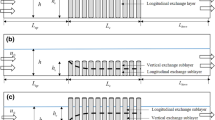...you know not the way of the wind... Ecclesiastes, Ch. XI, verse 5
Abstract
The conventional calculation of heat fluxes from a vegetated surface, involving the coefficient of turbulent heat transfer, which increases logarithmically with surface roughness (commonly taken as about 0.12 of the plant height), appears inappropriate for highly structured surfaces such as desertscrub or open forest. An approach is developed here for computing sensible heat flux from sparsely vegetated surfaces, where the absorption of insolation and the transfer of absorbed heat to the atmosphere are calculated separately for the plants and for the soil. This approach is applied to a desert-scrub surface for which the turbulent transfer coefficient of sensible heat flux from the plants is much larger than that from the soil below, as shown by an analysis of plant, soil and air temperatures measured in an animal exclosure in the northern Sinai. The plant density is expressed as the sum of products (plant-height) x (plant-diameter) of plants per unit horizontal surface area (the dimensionless silhouette parameter of Lettau). The solar heat absorbed by the plants is assumed to be transferred immediately to the airflow. The effective turbulent transfer coefficientk g-eff for sensible heat from the desert-scrub/soil surface computed under this assumption increases sharply with increasing solar zenith angle, as the plants absorb a greater fraction of the incoming irradiation. The surface absorptivity (the co-albedo) also increases sharply with increasing solar zenith angle, and thus the sensible heat flux from such complex surfaces (which include open forests) is a much broader function of time of day than when computed under constantk g-eff and constant albedo assumptions. The major role that desert-fringe plants play in the genesis of convection and advection cannot be evaluated properly in the conventional calculations.
Similar content being viewed by others
References
Anthes, R. A.: 1984, ‘Enhancement of Convective Precipitation by Mesoscale Variations in Vegetative Covering in Semi-arid Regions’,J. Climate Appl. Meteorol. 2, 541–554.
Blondin, C.: 1991, ‘Parameterization of Land Surface Processes in Numerical Weather Prediction’, Chapter 3, in: Land Surface Evaporation, Measurement and Parameterization, T. J. Schmugge and J. C. Andre, Eds., Springer-Verlag, New York, 31–54.
Brutsaert, W.: 1975, ‘A Theory for Local Evaporation (or heat transfer) From Rough and Smooth Surfaces at Ground Level’,Water Resour. Res. 11, 543–550.
Brutsaert, W.: 1982, ‘Evaporation Into the Atmosphere: Theory, History and Applications’, D. Reidel Publishing Co., Dordrecht, Holland, pp. 299.
Chamberlain, A. C.: 1968, ‘Transport of Gases to and from Surfaces With Bluff and Wave-Like Roughness Elements’,Quart, J. Roy, Meteorol. Soc. 94, 318–332.
Garratt, J. R., and Hicks, B. B.: 1973, ‘Momentum, Heat and Water Vapor Transfer to and From Natural and Artificial Surfaces’,Quart. J. Roy. Meteorol. Soc. 99, 680–687.
Lettau, H.: 1969, ‘Note on Aerodynamic Roughness-Parameter Estimation on the Basis of Roughness element description’,J. Appl. Meteorol. 8, 828–832.
Lumley, J. L.: 1992, ‘Some Comments on Turbulence’,Physics of Fluids A. 4, 203–211.
Otterman, J.: 1974, ‘Baring High-Albedo Soils by Overgrazing: a Hypothesized Desertification Mechanism’,Science 186, 531–533.
Otterman, J. and Fraser, R. S.: 1976, ‘Earth-Atmosphere System and Surface Reflectivities in Arid Regions from LANDSAT MSS data’,Remote Sensing of Environment 5, 247–266.
Otterman, J.: 1981a, ‘Satellite and Field Studies on Man's Impact on the Surface In Arid Regions’,Tellus 33, 68–77.
Otterman, J.: 1981b, ‘Plane with Protrusions as an Atmospheric Boundary’,J. Geophys. Res. 86, 6627–6630.
Otterman, J.: 1983, ‘Absorption of Insolation by Land Surfaces With Sparse Vertical Protrusions’,Tellus 35B, 309–318.
Otterman, J. and Tucker, C. J.: 1985, ‘Satellite Measurements of Surface Albedo and Temperatures in Semi Desert’,J. Climate Appl. Meteorol. 24, 228–235.
Otterman, J. and Brakke, T. W.: 1986, ‘Penetration of Sunlight Into a Canopy’,Boundary-Layer Meteorol. 36, 335–349.
Otterman, J.: 1989, ‘Enhancement of Surface-Atmosphere Fluxes by Desert-Fringe Vegetation Through Reduction of Surface Albedo and of Soil Heat Flux’,Theor. Appl. Climatol. 40, 67–79.
Otterman, J.: 1990, ‘A Simple Two-System Parameter Model for Surface Effected Warming of the Planetary Boundary Layer’,Boundary-Layer Meteorol. 51, 213–227.
Otterman, J., Manes, A., Rubin, S., Alpert, P., and Starr, D. O'C.: 1990, ‘An Increase of Early Rains in Southern Israel Following Land-Use Change?’,Boundary-Layer Meteorol. 53, 333–351.
Otterman, J. and Chou, M. D.: 1992, ‘Simulation of Desert-Scrub Growth: A Forcing to Warmer and More Pluvial Climate’,Advances in Atmospheric Sciences 4, 441–450.
Pielke, R. A.: 1984, ‘Mesoscale Meteorological Modeling’, Academic Press, New York, pp. 612.
Rosenberg, N. J.: 1974, ‘Microclimate: the Biological Environment’ John Wiley and Sons, New York, pp. 315.
Stathers, R. S., Black, T. A., Novak, M. D., and Bailey, W. A.: 1988, ‘Modeling Surface Energy Fluxes and Temperatures in Dry and Wet Bare Soils’,Atmosphere-Ocean 26, 59–73.
Stearns, C. R.: 1978, ‘Dynamic Interaction Between the Lower Atmosphere and the Desert Floor’, in: Exploring the World's Desert Climate, Eds. H. H. Lettau and K. Lettau, IES Report 101, University of Wisconsin-Madison, Wisconsin; Table 9 on p. 48.
Stull, R. B.: 1988, ‘An Introduction to Boundary-Layer Meteorology’, Kluwer Academic Press, Dordrecht, pp. 666.
Sud, Y., Shukla, J., and Mintz, Y.: 1980, ‘Influence of Land-Surface Roughness on Atmospheric Circulation and Rainfall; A Sensitivity Study with General Circulation Model’,J. Appl. Meteorol. 27, 1036–1054.
Thom, A.: 1971, ‘Momentum Absorption by Vegetation’,Quart. J. Roy. Meteorol. Soc. 97, 414–428.
Author information
Authors and Affiliations
Rights and permissions
About this article
Cite this article
Otterman, J., Novak, M.D. & Starr, D.O.C. Turbulent heat transfer from a sparsely vegetated surface: Two-component representation. Boundary-Layer Meteorol 64, 409–420 (1993). https://doi.org/10.1007/BF00711708
Revised:
Issue Date:
DOI: https://doi.org/10.1007/BF00711708




